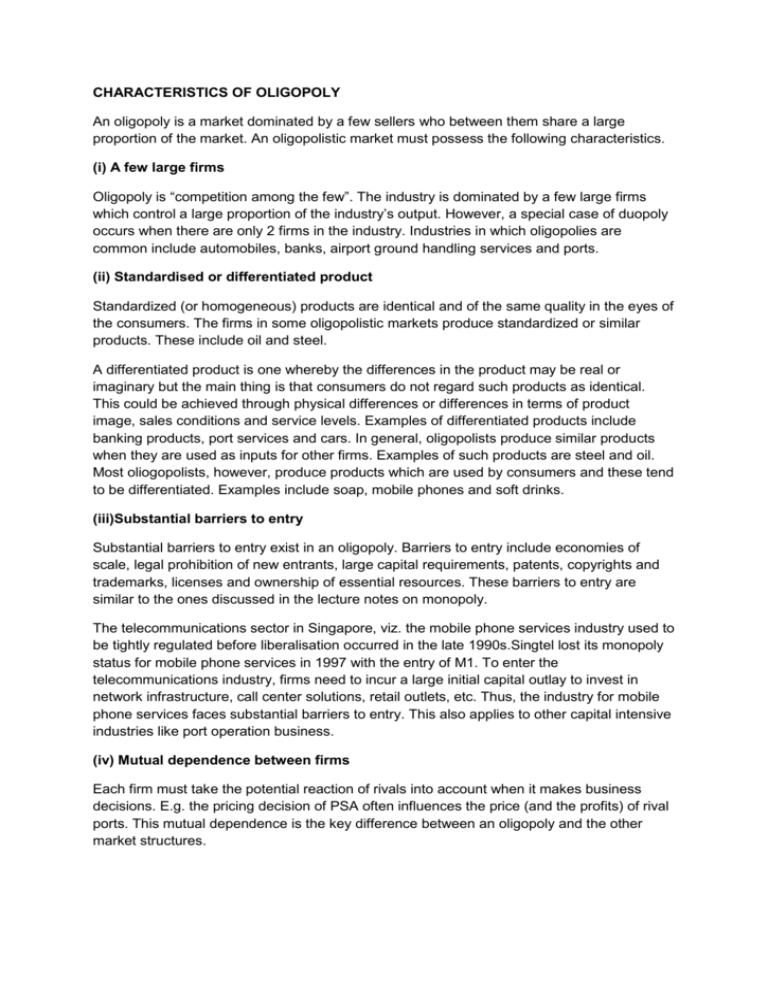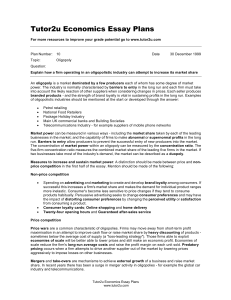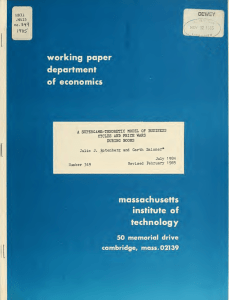CHARACTERISTICS OF OLIGOPOLY An oligopoly is a market
advertisement

CHARACTERISTICS OF OLIGOPOLY An oligopoly is a market dominated by a few sellers who between them share a large proportion of the market. An oligopolistic market must possess the following characteristics. (i) A few large firms Oligopoly is “competition among the few”. The industry is dominated by a few large firms which control a large proportion of the industry’s output. However, a special case of duopoly occurs when there are only 2 firms in the industry. Industries in which oligopolies are common include automobiles, banks, airport ground handling services and ports. (ii) Standardised or differentiated product Standardized (or homogeneous) products are identical and of the same quality in the eyes of the consumers. The firms in some oligopolistic markets produce standardized or similar products. These include oil and steel. A differentiated product is one whereby the differences in the product may be real or imaginary but the main thing is that consumers do not regard such products as identical. This could be achieved through physical differences or differences in terms of product image, sales conditions and service levels. Examples of differentiated products include banking products, port services and cars. In general, oligopolists produce similar products when they are used as inputs for other firms. Examples of such products are steel and oil. Most oliogopolists, however, produce products which are used by consumers and these tend to be differentiated. Examples include soap, mobile phones and soft drinks. (iii)Substantial barriers to entry Substantial barriers to entry exist in an oligopoly. Barriers to entry include economies of scale, legal prohibition of new entrants, large capital requirements, patents, copyrights and trademarks, licenses and ownership of essential resources. These barriers to entry are similar to the ones discussed in the lecture notes on monopoly. The telecommunications sector in Singapore, viz. the mobile phone services industry used to be tightly regulated before liberalisation occurred in the late 1990s.Singtel lost its monopoly status for mobile phone services in 1997 with the entry of M1. To enter the telecommunications industry, firms need to incur a large initial capital outlay to invest in network infrastructure, call center solutions, retail outlets, etc. Thus, the industry for mobile phone services faces substantial barriers to entry. This also applies to other capital intensive industries like port operation business. (iv) Mutual dependence between firms Each firm must take the potential reaction of rivals into account when it makes business decisions. E.g. the pricing decision of PSA often influences the price (and the profits) of rival ports. This mutual dependence is the key difference between an oligopoly and the other market structures. (v) Price rigidity Prices tend to be fairly rigid and do not change much in an oligopoly. Since firms are mutually dependent, each firm will need to consider the responses of rival firms to any price changes made by it. Thus, firms prefer to either engage in common price agreements or are reluctant to change prices at all. Price competition is avoided in an oligopoly. However, price wars do occur at times. They may arise in situations where a new firm enters and tries to establish its presence by undercutting its rivals. (vi) Non-price competition Firms in an oligopoly engage in non-price competition such as by competitive advertising, promotions e.g. the giving of free gifts, and product development. E.g. the three mobile phone operators in Singapore; Singtel, M1 and Starhub, advertise aggressively and provide attractive gifts and competitive packages to attract customers. BEHAVOUR OF OLIGOPOLISTIC FIRM: Collusive and non collusive Oligopoly 1. How an oligopolistic firm competes The mutual interdependence between oligopolists will either lead the firms to i) collude to maximize industry profits or ii) compete to gain a larger share of industry profits for themselves. (i) Firms collude Collusive Oligopoly One of the choices which could be adopted by oligopolists is to collude, to maximise industry profits. When firms collude, they agree to restrict competition among themselves and maximize their combined profits. They can decide to set output quotas, fix prices, limit product promotion or development. They could also agree not to ‘poach’ each other’s markets. Examples of collusion include cartels and price leadership. Cartels A cartel is a formal collusive agreement. All firms in a cartel will coordinate their activities so as to maximize industry profits, behaving as if they were a monopoly. In other words, cartel members agree to work together and behave like a monopoly. Therefore, the model used to analyse the price and output decisions of a collusive oligopoly is the same as that used to analyse monopoly. This is illustrated in Figure.








